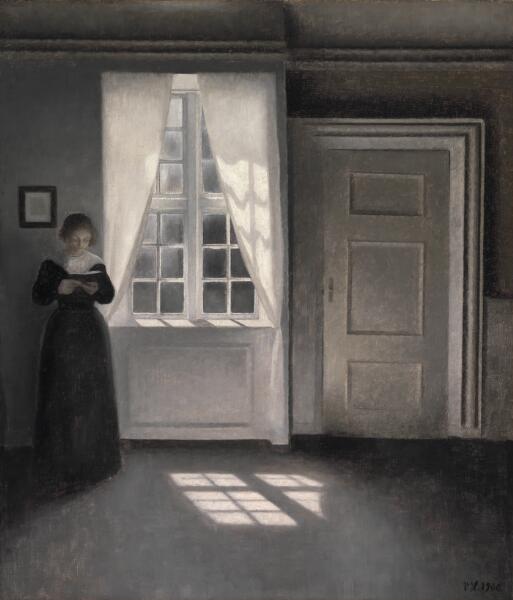Masterpiece by Vilhelm Hammershøi – Interior, Strandgade 30
At Tuesday's auction, the Danish painter Vilhelm Hammershøi's masterpiece "Interior, Strandgade 30" was sold for a price of DKK 31.5 million. It is the most expensive work of art ever sold in Denmark.
A Space for Reflection
|
At our Live Auction on 26 November, we presented an interior painting by Vilhelm Hammershøi (1864-1916) of Strandgade 30, where his wife Ida stands next to a window. This is Hammershøi at his best – depicting his residence in Christianshavn in the heart of Copenhagen, where he lived with Ida from 1898-1908. The two were engaged in 1890, and she became a model in many of his paintings. Hammershøi has few equals when it comes to painting enigmatic and atmospheric spaces. These interiors have made him the most sought-after Danish artist on the international art market. The painting from Strandgade 30 that is up for auction is a striking example of his abilities. Ida stands alone in a characteristically empty room with a beautifully profiled door, tall panels, plastered ceilings and paned windows, through which the light falls and is reflected on the floor. Hammershøi uses countless shades of white, grey and brown to create a space with a distinctly timeless metaphysical feel to it – a unique Hammershøi atmosphere. It is during his years in Christianshavn (1898-1908) that he achieves a breakthrough as a painter of interiors. The interiors are never direct representations of his surroundings, but rather subjective interpretations of the space that is always staged by himself. The conscious control of the setting, in conjunction with the almost abstract aesthetic beauty and clear musical qualities of the created space, makes Hammershøi a key figure of Danish Symbolism. |
|
|
"Why do I use so few and muted colours? Frankly, I don’t know. It’s quite impossible for me to say anything on the matter. It feels natural to me. In purely colouristic terms, I absolutely believe that a painting works best the fewer colours are used in it (...) I have mostly painted interiors (...) How did I end up doing this? (…) It’s difficult to say. It just happened. And it is fashionable right now, everyone wants interiors, they hardly want anything else. When I paint a landscape, I usually can't sell it"
Vilhelm HammershøiInterview in the journal Hver 8. Dag (Every 8th Day) in 1907
The Artist Behind the Interior
|
Vilhelm Hammershøi was a controversial painter, and many contemporary Danes did not understand his art. He had several works rejected from the official art exhibitions at Charlottenborg in Copenhagen, but today he is one of the most sought-after artists. His works are on display at museums all over the world, including the National Gallery of Denmark, The Hirschsprung Collection, The David Collection and Ordrupgaard Museum in Denmark as well as Musée d’Orsay in Paris, The National Museum of Western Art in Tokyo, The Metropolitan Museum of Art in New York, Hamburger Kunsthalle and Tate in London. Hammershøi began studying painting already at the age of eight. At the age of fourteen, he was admitted to the Royal Danish Academy of Fine Arts in Copenhagen, where he received his formal education from 1879-84. Following this, he studied under P.S. Krøyer at Kunstnernes Frie Studieskoler (The Free School of Study for Artists) from 1883-85. |

|
“I have a student who paints quite peculiarly. I do not understand him, believe that he will become significant, am trying not to influence him."
P.S. Krøyer1885
International Interest and Inspiration
|
Hammershøi's rare talent earned him great international acclaim even during his own lifetime. His artwork captivated important cultural figures of the time such as Auguste Renoir, Théodore Duret, Rainer Maria Rilke and others. He was an elusive, reflective and taciturn person who did not reveal which artists inspired him. However, Hammershøi's first trip abroad to Holland and Belgium in 1887 was undoubtedly due to his interest in Dutch painters. These included Jan Vermeer van Delft (1632-1675), whose paintings are characterised by a similar approach to framing, overlaps, empty spaces and a restrained colour palette. The interiors of Pieter de Hooch (1629-1684) with their open doors, where you can see from room to room, and Pieter Saenredam's (1597-1665) clear and harmonious depictions of buildings, have also served as inspiration for Hammershøi. The works of the American painter James McNeill Whistler (1834-1903) have likewise been of importance to the Danish painter. Furthermore, the proliferation of the photographic medium and its influence on the perception of light, framing, motifs etc. played a colossal role in Hammershøi's art.
|
|
|
Additional Works by Hammershøi at the AuctionAdditional, and quite diverse, works by Hammershøi were also for sale at the Live Auction:
|

"Interior, Strandgade 30"
Articles by international and Danish experts on Hammershøi: MaryAnne Stevens, Frank Claustrat, Jesper Svenningsen, Gertrud Oelsner and Annette Rosenvold Hvidt.

For further information regarding:
The artwork: please contact Julie Arendse Voss via +45 8818 1123 / jav@bruun-rasmussen.dk
Press material: please contact Charlotte Kiberg via +45 8818 1064 / cki@bruun-rasmussen.dk

